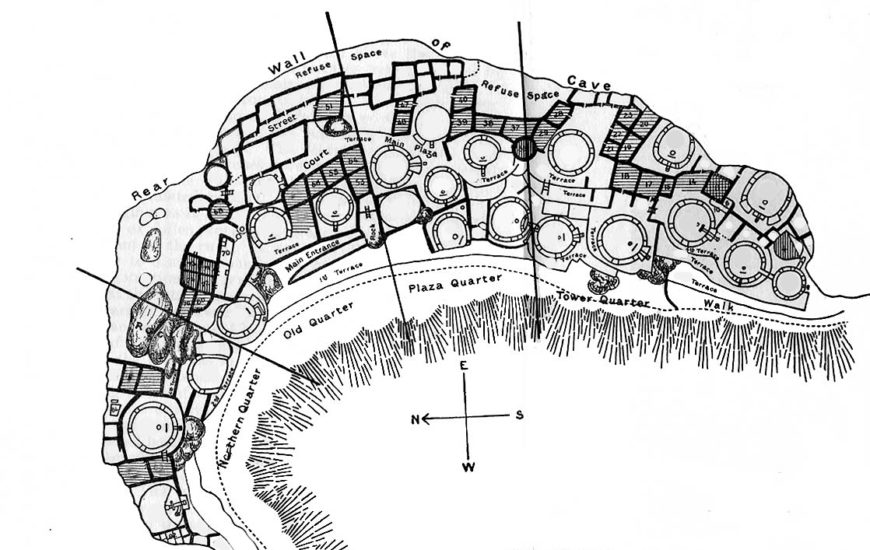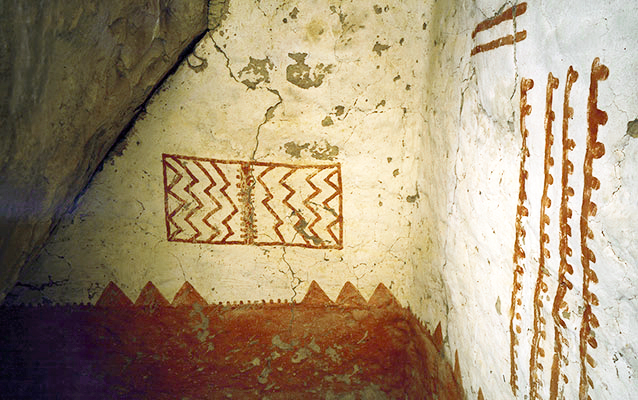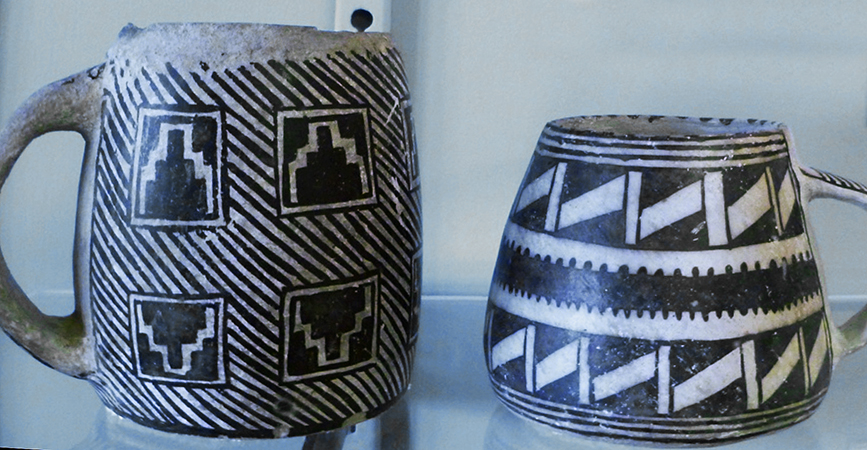Remarkable structures in the American Southwest were home to cliff-dwelling farmers until around 1300.
Mesa Verde and the preservation of Ancestral Puebloan heritage ARCHES: At Risk Cultural Heritage Education Series. Speakers: Dr. Lauren Kilroy-Ewbank and Dr. Steven Zucker
[0:00] [music]
Dr. Steven Zucker: [0:06] Mesa Verde is one of the most spectacular archaeological sites in the world.
Dr. Lauren Kilroy-Ewbank: [0:10] The largest archaeological site in the United States. There are more than 4,300 sites and more than 600 cliff dwellings.
Dr. Zucker: [0:18] Which draws upwards to half a million visitors every year. The topography is spectacular — flat-topped mesas with deep, steep ravines — and human settlements were built both on top of the mesas but also along the cliffs. We think the site was inhabited for centuries, but ultimately it was abandoned.
Dr. Kilroy-Ewbank: [0:38] The Ancestral Puebloans who have lived at Mesa Verde were the ancestors of the Pueblo peoples that you find in the American Southwest today.
Dr. Zucker: [0:46] There are certain continuities. Modern Puebloans are well known for their ceramics, for their basket weaving, and these are traditions that we can trace back to these more ancient people.
Dr. Kilroy-Ewbank: [0:56] People who were living in Mesa Verde and in other parts of the Four Corners region, they were trading extensively with peoples not just within the American Southwest region. You find evidence for trade south into what is today Mexico, what we call back then Mesoamerica.
Dr. Zucker: [1:11] This is so interesting because now we think of the border between the United States and Mexico as a hard line. We often differentiate peoples from Mesoamerica from Native North American peoples. But that border is political and modern and was not in existence. These Ancestral Puebloans built these extraordinary structures, full-scale cities.
Dr. Kilroy-Ewbank: [1:30] If we’re talking about the cliff dwellings, they’re set into the face of the cliff. They are built using stone but also mud and various other organic materials. What this means is that people have to constantly maintain these types of structures.
Dr. Zucker: [1:46] Because although they’re set within the cliff face, they are still exposed. Archaeologists believe that by the year 1300, most of these sites were abandoned. And there are various competing theories as to why this took place.
Dr. Kilroy-Ewbank: [1:58] Maybe there were problems with the weather that was forcing them to move, maybe it was water access. We’re not entirely sure what caused people to abandon Mesa Verde. What we do know is that largely after 1300, most of these cliff dwellings are no longer in use, meaning that they are not being maintained.
Dr. Zucker: [2:14] Fast-forward to the modern world and to modern tourism and you have stresses on these structures that are not only the result of lack of maintenance but now also heavy foot and vehicle traffic.
Dr. Kilroy-Ewbank: [2:25] Stabilization issues are some of the main problems facing the conservation and preservation of places like Cliff Palace. Many of these cliff dwellings don’t have permanent foundations because they’re set into the face of the cliff.
[2:38] So with the heavy foot traffic, with extreme weather, particularly heat that is affecting the site, as well as things like pollution, you have structures that are cracking or falling apart. [At] Cliff Palace, in 2011, one of the kivas collapsed, and as of 2015, because of dangerous rock falls, Spruce Tree House is no longer open to the public.
Dr. Zucker: [3:01] Tourism is only one part of the stress that Mesa Verde is facing. Forest fires have also posed a major environmental threat.
Dr. Kilroy-Ewbank: [3:09] Fires in the late ’90s and the early 2000s destroyed almost half of the park. Even though they were responsible for destroying various local flora and fauna, the fires did help to uncover a very large number of unknown sites.
[3:23] The site is facing a lot of stresses. The rediscovery of Mesa Verde occurred in the late 19th century when cattle ranchers discovered Mesa Verde in the winter. Now, we know that they were not the first people here since it was abandoned.
Dr. Zucker: [3:37] And of course, Native American peoples in the area knew about these structures.
Dr. Kilroy-Ewbank: [3:41] What happened with these cattle ranchers is they kicked off this desire for people who were interested in the past of this area, and the so-called exploration and excavation of Mesa Verde.
Dr. Zucker: [3:51] One could call that exploration a type of looting.
Dr. Kilroy-Ewbank: [3:54] People were stealing things. They were camping out in some of the dwellings. There was basically nothing in place to protect Mesa Verde. We know for instance, in the late 19th century, there was someone who took artifacts and human remains back to Sweden.
[4:09] This brings us back to the problems with some of the excavations or the looting that took place from the late 19th century into the 20th century. There were people who stepped in to try to conserve and to prevent further damage.
[4:24] One of the most important individuals for this was Jesse Walter Fewkes of the Smithsonian, who had done excavations in the American Southwest. He was writing about the need to have some type of rules or [legislation] in place that would help to stop the destruction of places like Mesa Verde.
Dr. Zucker: [4:42] Even as the dwellings themselves were being secured, archaeological excavations were continuing that were unearthing human remains that we now realize should have remained in place. In 1990, a law was passed that goes by the acronym NAGPRA.
Dr. Kilroy-Ewbank: [4:57] NAGPRA stands for the Native American Graves Protection and Repatriation Act.
Dr. Zucker: [5:02] What that did is to give legal standing to the idea that museums or other cultural institutions that held Native American human remains should return those to communities that had some connection to those original peoples.
Dr. Kilroy-Ewbank: [5:13] There was also sacred objects, maybe objects that were not intended to ever be on display for certain peoples, ones that were intended to accompany the dead into the grave. What NAGPRA did was allow different groups, tribes, First Nations to receive these objects and human remains and to properly re-bury them.
Dr. Zucker: [5:33] The human remains were re-buried in a private ceremony in 2006.
Dr. Kilroy-Ewbank: [5:39] Also, grave goods that had been in collections were re-buried in this ceremony. It was over the course of 12 years in association with 24 different tribes that all of these human remains and goods were collected to be re-buried.
Dr. Zucker: [5:53] Mesa Verde remains a tremendously popular tourist site. It’s also a lens through which we can understand the difficulties of preserving a historical site that remains central to the culture, the history, and the interests of contemporary Native communities.
[6:08] [music]
Wanted: stunning view
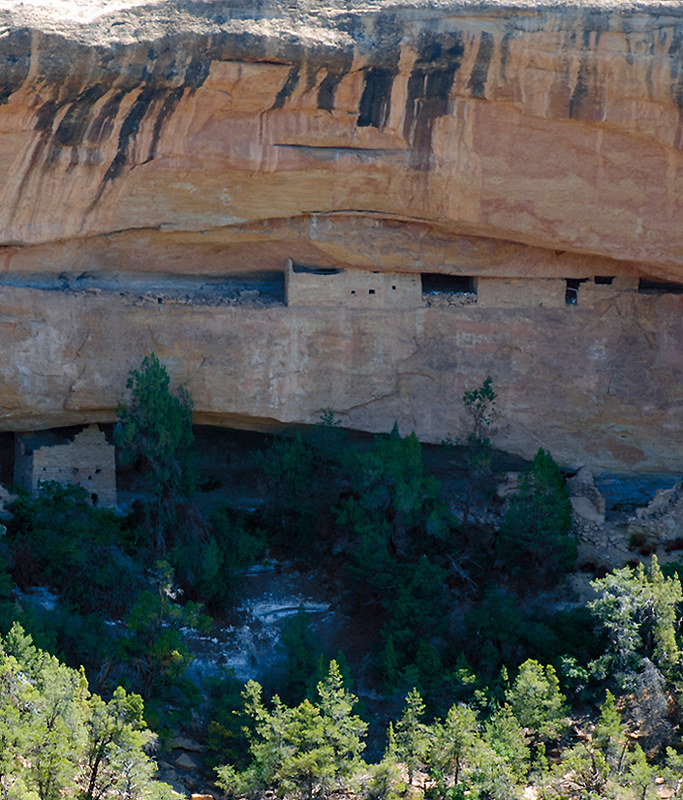
Cliff dwellings, Ancestral Puebloan, 450–1300 C.E., sandstone, Mesa Verde National Park, (photo: Steven Zucker, CC BY-NC-SA 2.0)
Imagine living in a home built into the side of a cliff. The Ancestral Puebloan peoples (formerly known as the Anasazi) did just that in some of the most remarkable structures still in existence today. Beginning after 1000–1100 C.E., they built more than 600 structures (mostly residential but also for storage and ritual) into the cliff faces of the Four Corners region of the United States (the southwestern corner of Colorado, northwestern corner of New Mexico, northeastern corner of Arizona, and southeastern corner of Utah). The dwellings depicted here are located in what is today southwestern Colorado in the national park known as Mesa Verde (“verde” is Spanish for green and “mesa” literally means table in Spanish but here refers to the flat-topped mountains common in the southwest).
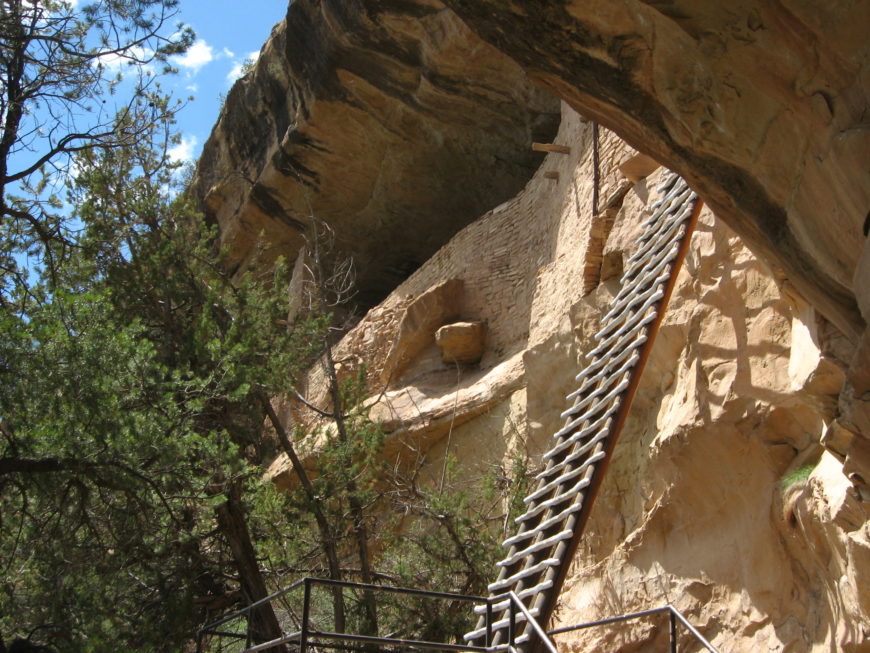
Ladder to Balcony House, Mesa Verde National Park (photo: Ken Lund, CC BY-SA 2.0)
The most famous residential sites date to the twelfth and thirteenth centuries. The Ancestral Puebloans accessed these dwellings with retractable ladders, and if you are sure footed and not afraid of heights, you can still visit some of these sites in the same way today.
To access Mesa Verde National Park, you drive up to the plateau along a winding road. People come from around the world to marvel at the natural beauty of the area as well as the archaeological remains, making it a popular tourist destination.
The twelfth- and thirteenth-century structures made of stone, mortar, and plaster remain the most intact. We often see traces of the people who constructed these buildings, such as hand or fingerprints in many of the mortar and plaster walls.
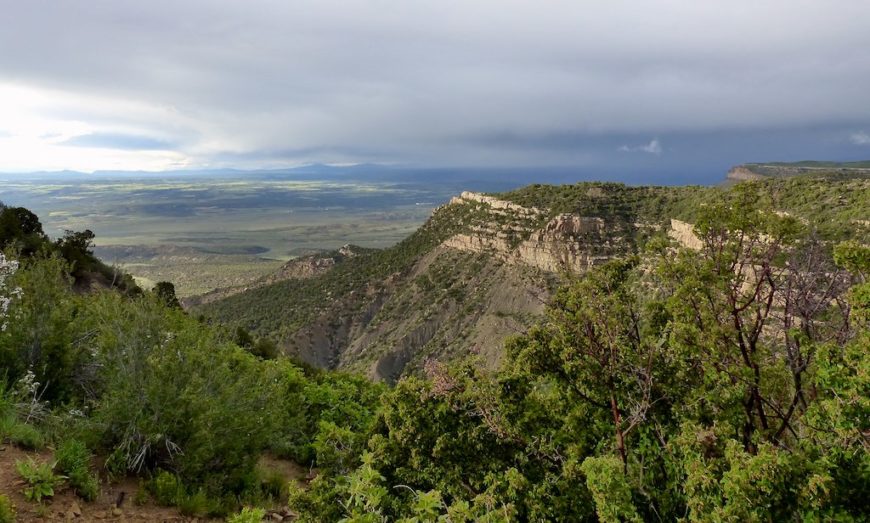
View of a canyon, Mesa Verde National Park, Colorado (photo: FancyLady, CC BY-ND 2.0)
Ancestral Puebloans occupied the Mesa Verde region from about 450 C.E. to 1300 C.E. The inhabited region encompassed a far larger geographic area than is defined now by the national park, and included other residential sites like Hovenweep National Monument and Yellow Jacket Pueblo. Not everyone lived in cliff dwellings. Yellow Jacket Pueblo was also much larger than any site at Mesa Verde. It had 600–1200 rooms, and 700 people likely lived there (see link below). In contrast, only about 125 people lived in Cliff Palace (largest of the Mesa Verde sites), but the cliff dwellings are certainly among the best-preserved buildings from this time.
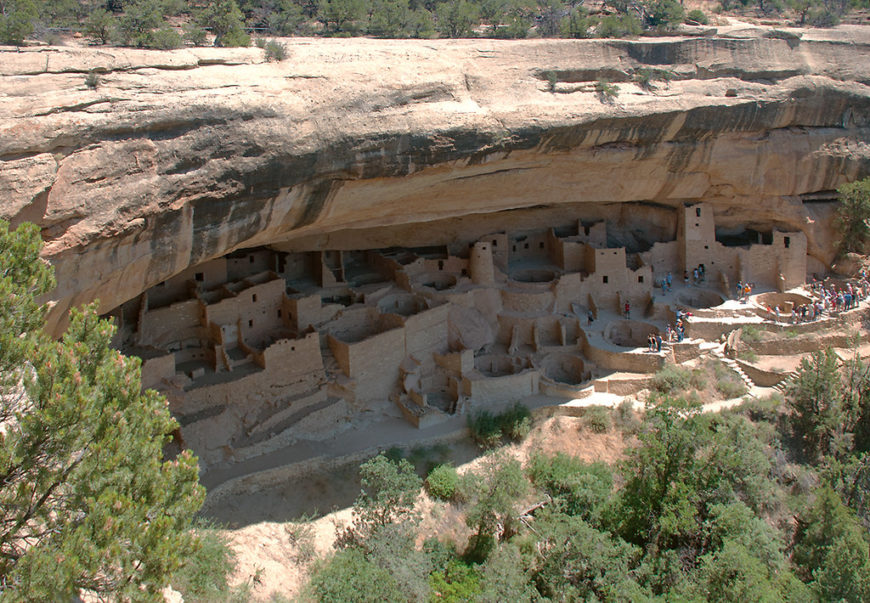
Cliff Palace, Ancestral Puebloan, 450–1300 C.E., sandstone, Mesa Verde National Park, Colorado (photo: Steven Zucker, CC BY-NC-SA 2.0)
Cliff palace
The largest of all the cliff dwellings, Cliff Palace, has about 150 rooms and more than twenty circular rooms. Due to its location, it was well protected from the elements. The buildings ranged from one to four stories, and some hit the natural stone “ceiling.” To build these structures, people used stone and mud mortar, along with wooden beams adapted to the natural clefts in the cliff face. This building technique was a shift from earlier structures in the Mesa Verde area, which, prior to 1000 C.E., had been made primarily of adobe (bricks made of clay, sand and straw or sticks). These stone and mortar buildings, along with the decorative elements and objects found inside them, provide important insights into the lives of the Ancestral Puebloan people during the thirteenth century.
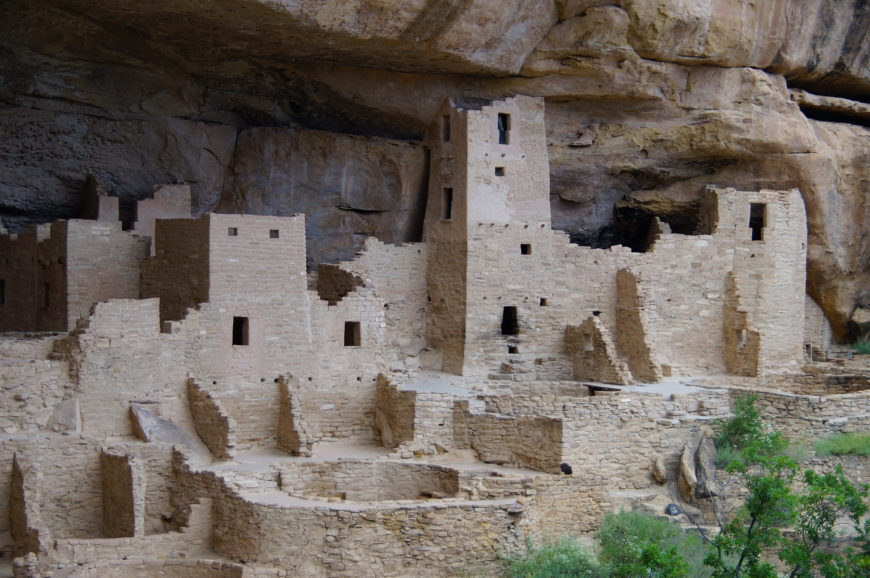
View of Cliff Palace structures, Mesa Verde (photo: steeleman204, CC BY-NC-ND 2.0)
At sites like Cliff Palace, families lived in architectural units, organized around kivas (circular, subterranean rooms). A kiva typically had a wood-beamed roof held up by six engaged support columns made of masonry above a shelf-like banquette. Other typical features of a kiva include a firepit (or hearth), a ventilation shaft, a deflector (a low wall designed to prevent air drawn from the ventilation shaft from reaching the fire directly), and a sipapu, a small hole in the floor that is ceremonial in purpose. They developed from the pithouse, also a circular, subterranean room used as a living space.
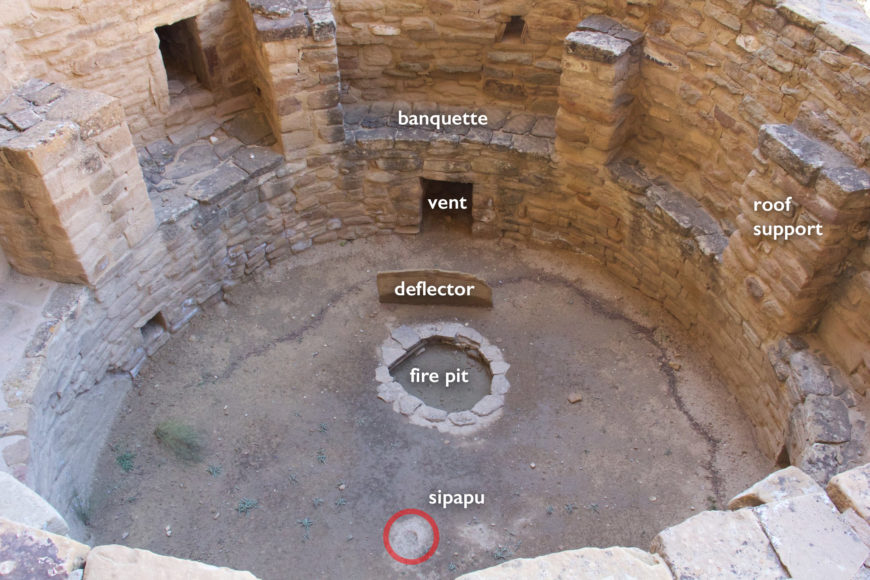
Kiva without a roof, Cliff Palace, Mesa Verde National Park (photo: Adam Lederer, CC BY-NC-SA 2.0)
Kivas continue to be used for ceremonies today by Puebloan peoples though not those within Mesa Verde National Park. In the past, these circular spaces were likely both ceremonial and residential. If you visit Cliff Palace, you will see the kivas without their roofs (see above), but in the past they would have been covered, and the space around them would have functioned as a small plaza.
Connected rooms fanned out around these plazas, creating a housing unit. One room, typically facing onto the plaza, contained a hearth. Family members most likely gathered here. Other rooms located off the hearth were most likely storage rooms, with just enough of an opening to squeeze your arm through a hole to grab anything you might need. Cliff Palace also features some unusual structures, including a circular tower. Archaeologists are still uncertain as to the exact use of the tower.
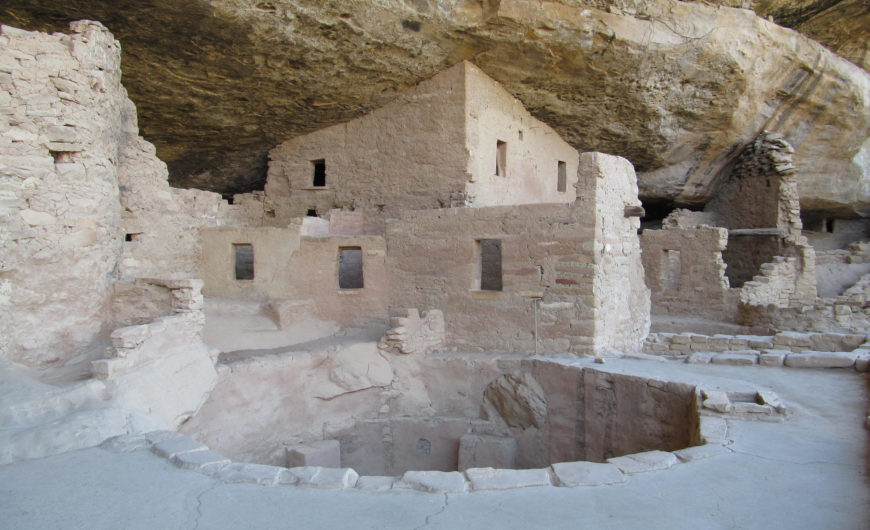
Kiva at Spruce Tree House, Mesa Verde National Park (photo: Doug Kerr, CC BY-SA 2.0)
Painted murals
The builders of these structures plastered and painted murals, although what remains today is fairly fragmentary. Some murals display geometric designs, while other murals represent animals and plants.
For example, Mural 30, on the third floor of a rectangular “tower” (more accurately a room block) at Cliff Palace, is painted red against a white wall. The mural includes geometric shapes that are thought to portray the landscape. It is similar to murals inside of other cliff dwellings including Spruce Tree House and Balcony House. Scholars have suggested that the red band at the bottom symbolizes the earth while the lighter portion of the wall symbolizes the sky. The top of the red band, then, forms a kind of horizon line that separates the two. We recognize what look like triangular peaks, perhaps mountains on the horizon line. The rectangular element in the sky might relate to clouds, rain or to the sun and moon. The dotted lines might represent cracks in the earth.
The creators of the murals used paint produced from clay, organic materials, and minerals. For instance, the red color came from hematite (a red ocher). Blue pigment could be turquoise or azurite, while black was often derived from charcoal. Along with the complex architecture and mural painting, the Ancestral Puebloan peoples produced black-on-white ceramics and turquoise and shell jewelry (goods were imported from afar including shell and other types of pottery). Many of these high-quality objects and their materials demonstrate the close relationship these people had to the landscape. Notice, for example, how the geometric designs on the mugs above appear similar to those in Mural 30 at Cliff Palace.
Why build here?
From 500–1300 C.E., Ancestral Puebloans who lived at Mesa Verde were sedentary farmers and cultivated beans, squash, and corn. Corn originally came from what is today Mexico at some point during the first millennium of the Common Era. Originally most farmers lived near their crops, but this shifted in the late 1100s when people began to live near sources of water, and often had to walk longer distances to their crops.
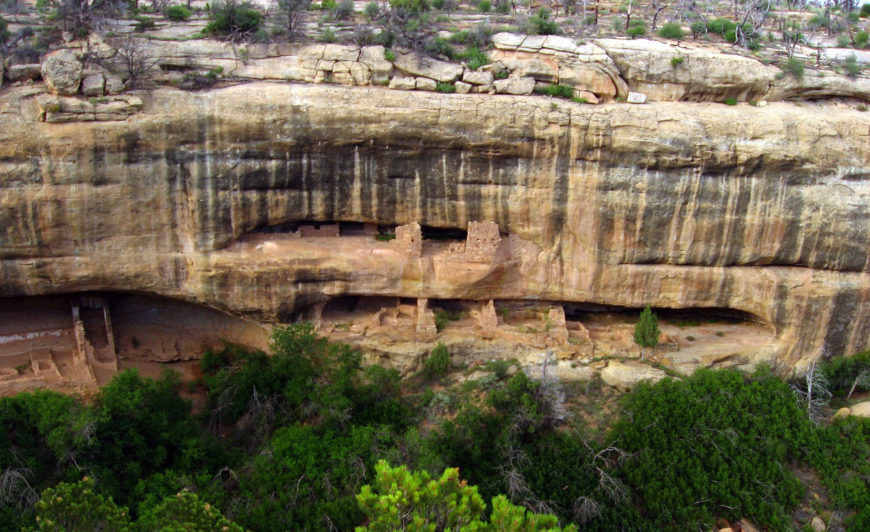
New Fire House, Masa Verde National Park (photo: Ken Lund, CC BY-SA 2.0)
So why move up to the cliff alcoves at all, away from water and crops? Did the cliffs provide protection from invaders? Were they defensive or were there other issues at play? Did the rock ledges have a ceremonial or spiritual significance? They certainly provide shade and protection from snow. Ultimately, we are left only with educated guesses—the exact reasons for building the cliff dwellings remain unknown to us.
Why were the cliffs abandoned?
The cliff dwellings at Mesa Verde were abandoned around 1300 C.E. After all the time and effort it took to build these beautiful dwellings, why did people leave the area? Cliff Palace was built in the twelfth century, why was it abandoned less than a hundred years later? These questions have not been answered conclusively, though it is likely that the migration from this area was due to either drought, lack of resources, violence or some combination of these. We know, for instance, that droughts occurred from 1276 to 1299. These dry periods likely caused a shortage of food and may have resulted in confrontations as resources became more scarce. The cliff dwellings remain, though, as compelling examples of how the Ancestral Puebloans literally carved their existence into the rocky landscape of today’s southwestern United States.

